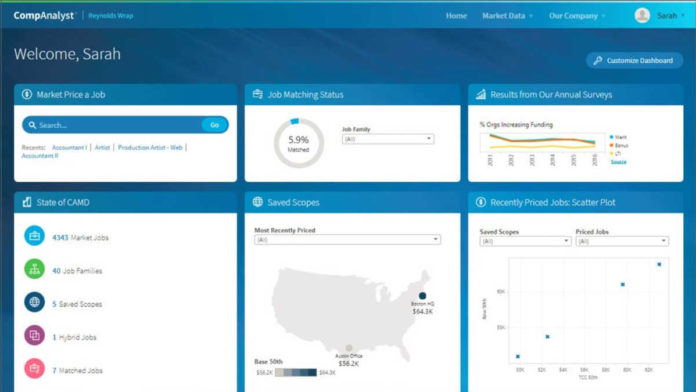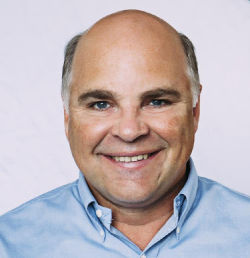
In March, Lighthouse Research & Advisory included Salary.com’s CompAnalyst platform in its Compensation Technology Buyer’s Guide and Provider Landscape. Soon after, we spoke with Salary.com CEO Kent Plunkett, CCP, about why compensation data matters, his company’s business, and how both will evolve in the post-pandemic world.
Candidates and employees recognize Salary.com as a provider free salary data. But CompAnalyst’s compensation data is different. How so?
What we try to do is give people accurate data so they can make high-quality decisions. That being said, we provide CompAnalyst data, which is based on machine learning derived something called regression analysis. It’s predictive data, that answers the question of what is fair pay. We’ve been running that process since 2001, so for almost 20 years now.
We build that data set by purchasing surveys, and survey data is the gold standard in compensation work. We take the surveys and analyze them to build the CompAnalyst data set.
Our free data is national average regression data. So predictive data, adjusted for cost-of-living and some other kinds of macro adjustments that are imposed at the national level. The CompAnalyst data is built much more granularly to be the most accurate answer that we can come up with—based upon more of the specific regression analysis in local markets—in a particular industry. So it’s more detailed as opposed to national average data that’s locally adjusted.
Q&A w/Salary.com CEO Kent Plunkett: Why compensation data matters, his company's business, and how both will evolve in the post-pandemic world. @Salary #HR #HRTech #HRTribe Share on XSo you’re teasing more out of it?
Exactly. Basically, the free data is national average data with some local adjustments that are done on a macro level. The CompAnalyst data provides the same answer that a compensation professional would derive if they went through three hours of work to come up with a number that is very specific and very targeted and tailored to a particular position.
I probably should have started this answer by saying we also have a big survey business. We’re the third-largest survey company in the U.S. today behind Mercer and Willis Towers Watson. If you take all the survey data that’s produced [by Salary.com and others], it might cover about 2 million combinations of jobs, industry, locations across the U.S. Our predictive data generates over 800 million data points from the 2 million. So CompAnalyst makes really big data out of big data.
Using regressions, it expands the data from surveys to predict data that is not surveyed. For example, our data will show what a nuclear engineer in Anchorage, Alaska, makes, even though there aren’t any people in that job living in Anchorage, Alaska. That prediction would be built by analyzing the data where there’s survey data available, say in New Hampshire and in Plymouth, Mass., and maybe Dover, Del. It would make adjustments for the weather conditions, scarcity of talent and the extra cost of living in Anchorage, and predict what the pricing would be for that job in Anchorage.
So survey data footnotes go right back to what employers submitted. Predictive data takes that and explodes it into a super big data set, which a comp professional can access and get a number in 30 seconds.
Can you give me an example of how an employer uses this data?

What some customers might do to price a job, or to price all of their jobs, would be to put the data into a spreadsheet. The alternative is to put it into a system. Fundamentally, what you’re hoping to do is use multiple sources of data to triangulate the right answer.
In a perfect world, you would use CompAnalyst Market Data, maybe CompAnalyst survey data, and a Mercer survey data point. And you’d get three different data points for what you should pay your staff accountant. Then you’d triangulate it and say, “Okay, I kind of believe the Salary.com number more than I believe the Mercer number, and the Mercer job description is a little bit higher-level than the Salary.com description, so I’m going to tease up the number a little bit. And that’s my answer.”
Most people who are hard-core comp people will try to use three sources of data. The HR generalist who’s doing a project, or the small business that has less time and energy, will typically pick one survey. They’re better off, frankly, picking our CompAnalyst database, which is based on the data from hundreds of surveys all processed and integrated and aggregated. And they’ll just use the number they get out of our system or out of a survey directly to price the job.
And what kind of employers are you targeting with this?
Enterprises, anyone with more than say, about 500 employees, typically have a compensation team that’s dedicated to making sure that the company pays its people just like the three little bears: not too hot, not too cold. Right? Too cold and you get turnover. Too hot and you’re eating into your profit. So you try to be right in the middle.
Then there’s more folks out there who can, as employees, see on our site or on Glassdoor or on Indeed a number which suggests what they’re actually worth. That puts more pressure on management to be accountable and to be transparent and visible. So increasingly, smaller and smaller companies are doing compensation work so that they’re in a position to have an open and transparent conversation with their employees about being able to explain how and why they’re paid what they’re paid.
That’s a really important component of the employee experience, and it’s kind of under-reported. I think that compensation is still the key determinant of the employee experience, believe it or not. You’ve got other factors, too, like your relationship with your boss, the environment, your division and leadership and the company and then your work opportunity. So there’s a lot of components today, but I do think that a lot of HR is missing the fact that compensation still plays a big role in determining the employee experience.
Could you expand on that a little bit?
Sure. I just think that the vendor discussion out there is what’d I’d call “under-serving” it when they say, “Oh, well, wellness is important or performance management is important, and your benefits are important,” when they’re trying to put together a complete equation. Because compensation is so hard to do, I think that most of the marketing out there in HR tech today largely ignores the number one driver, which is whether your compensation is fair and transparent and equitably distributed.
When you think about presenting your value proposition to employers, what are the problems you’re trying to solve? Or what are the problems that employers expect you to help them solve?
The first thing is that our customer is typically completely overwhelmed. They have more work to do than they could possibly get done in a year. So they’re coming to us and looking for how can they be more efficient and effective in getting pay right, so that they can move on to do other things, as well. That’s probably the number one thing that drives people to work with us on a broad base.
If you’re struggling to find the right data, we offer literally hundreds of different data sets. It’s really hard to find the breadth of coverage that we can offer so that you don’t have to go searching from multiple vendors to get lots of different data sets. And if you look at what drives compensation professionals and HR people doing compensation projects, they’re often looking for a little more data to support the decision they think they need to make.
We’re in the middle of a pandemic. It’s probably going to go on for a while and it’s obviously going to have an impact on the economy. Do you think it’s going to change how employers approach and research compensation, at least for a little while?
I actually think, first of all, that we’re in something that has an outer limit anywhere from three months to 18 months. Let’s phrase it like that. And the likelihood is that in six to eight months we are where we are and people will be emerging. That to us is not going to disrupt the primary cycle of doing comp work.
I think the world of work will be different next winter than it is today. I believe that we are already seeing spot-market “recruiting” compensation levels drop and we are going to end up with a world where the job that was paid at $100,000 a year is going to be paid at a lower level next year. Market pricing driven compensation levels are being reset. And that is going to drive more companies, not fewer companies, to do compensation work next year.
Do you see your approach to marketing and sales changing as things settle down or will you remain the way you’ve been?
I think like every other company, we are looking hard at whether this is the right time to be spending sales and marketing budget on new business, or should we be helping our customers and, to the extent possible, the global community navigate this crisis. Our focus for the last couple of weeks has been on helping the global community—and obviously our customers are part of that—to navigate the crisis properly.
Can you give me an example?
We had a very successful webinar where we went out and found someone that we think is a leading leadership coach, who has a lot of experience with pandemics and had done a lot of organizational prep for the Ebola crisis. We had him going through some of the things you can do to get ready culturally for dealing with the fear and the radical shifts in the workplace.
In addition, we’re studying what’s going to happen with the disruptions in the labor market over the next couple of months, and trying to make sure that we are ahead of the curve in keeping our customers alert as to what the compensation landscape will look like next year.
We’ll also share that information with employees because, if you’re looking for a job or are about to take a job, one of the hardest things to do is actually understand if the job offer is fair. I think “fair” is going to be a lower number next year than it was this year, and it’s going to be part of our responsibility to track that and report on that in a way that is critically sound and can help people make the right decisions for themselves and their families as things reset and change.
Sign up for our newsletter here.
Image: Salary.com














